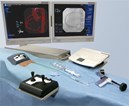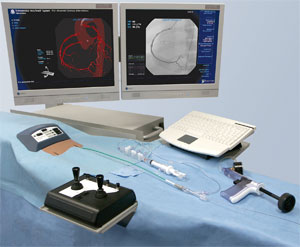Immersion Medical Expands Endovascular Medical Simulation Capabilities

 San Jose, CA - Immersion Corporation, a leading developer and licensor of touch feedback technology, recently announced that Immersion Medical has updated its endovascular platform with features that allow it to simulate a wider range of procedures. The new platform, now called the CathLabVR system, allows surgical simulation with as many as four devices or tools and for procedures involving more regions of the body. In addition, Immersion Medical's physics-based medical simulation software, haptic (force feedback) technology, and medical graphics expertise allow the company to produce specialized surgical simulations to meet a wide range of medical virtual reality training needs for device manufacturers and teaching institutions.
San Jose, CA - Immersion Corporation, a leading developer and licensor of touch feedback technology, recently announced that Immersion Medical has updated its endovascular platform with features that allow it to simulate a wider range of procedures. The new platform, now called the CathLabVR system, allows surgical simulation with as many as four devices or tools and for procedures involving more regions of the body. In addition, Immersion Medical's physics-based medical simulation software, haptic (force feedback) technology, and medical graphics expertise allow the company to produce specialized surgical simulations to meet a wide range of medical virtual reality training needs for device manufacturers and teaching institutions.
"These really are pioneering times," says Michael Freiborg, product development manager, Medtronic Cardiac Rhythm Disease Management. "Medtronic is continually developing new and improved products that help enrich the lives of patients, and with new products comes new surgical procedures and skill levels for the implanting physician. It's preferable when a physician or fellow can practice on Immersion Medical's surgical simulator because it allows them to become familiar with navigating the tools within a ‘virtual heart.' Practicing on the simulator helps them achieve a skill level that is needed before entering into real-life scenarios. Each case will be different, but the CathLabVR system's haptic feedback offers an actual feeling of what happens during the medical procedure."
As medical therapies and procedures become more sophisticated, medical simulators must advance to keep pace. As an example, a Medtronic minimally invasive therapy for arrhythmia requires the use of four tools simultaneously. The CathLabVR virtual reality education system provides this capability, as well as a new feature called SmartCapture tool recognition that automatically identifies the tools in use and functions more like the real catheterization lab environment.
"Immersion Medical's CathLabVR system helps us train implanting physicians on procedures ranging from a pacemaker lead implant to the steps required for more complex cardiac resynchronization therapy (CRT)," continues Freiborg. "The CRT procedure requires the use of cannulation and subselection catheters, guide wires, balloon inflation, contrast injections, and pacing lead placement. I don't believe there is another surgical simulator manufactured today that has this advanced capability."
In addition to coronary treatments, physicians use endovascular procedures to treat several other diseases. Peripheral arterial disease, referring to diseases of blood vessels outside the heart and brain, affects 8-12 million Americans.1 The longer carriage length of Immersion Medical's new CathLabVR system increases training capabilities by supporting additional surgical simulations, for example, deployment of carotid interventions.
"The field of medicine is constantly innovating, particularly in the area of endovascular interventions," said Mark Meents, vice president, sales and marketing, at Immersion Medical. "We believe we are uniquely qualified to support the industry with a virtual reality surgical simulation training platform for deployment of endovascular therapies from head to lower limb."
1 American Heart Association, Peripheral Artery Disease (PAD), http://www.americanheart.org/presenter.jhtml?identifier=3020242 (accessed March 28, 2007).
SOURCE: Immersion Corporation
